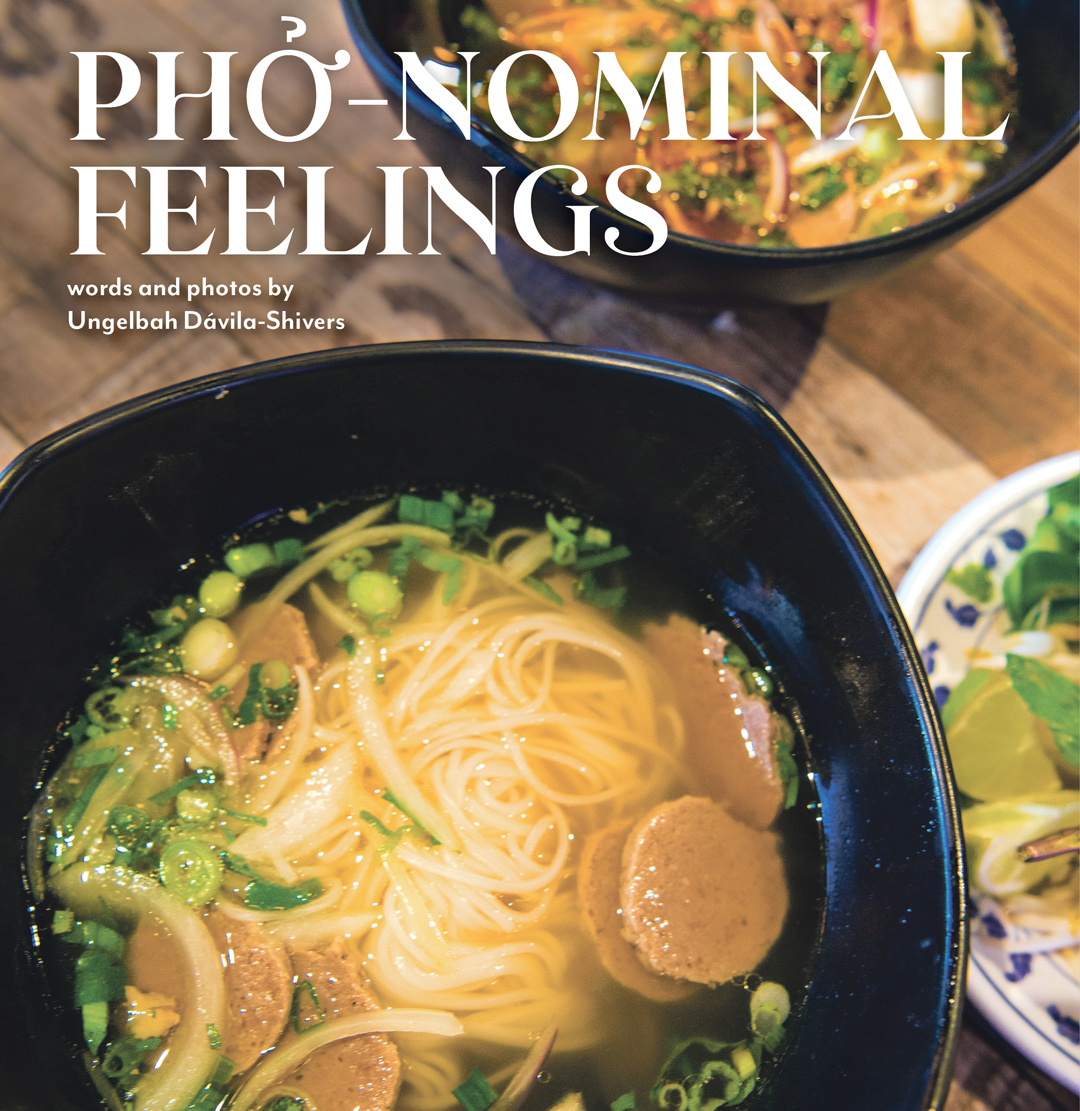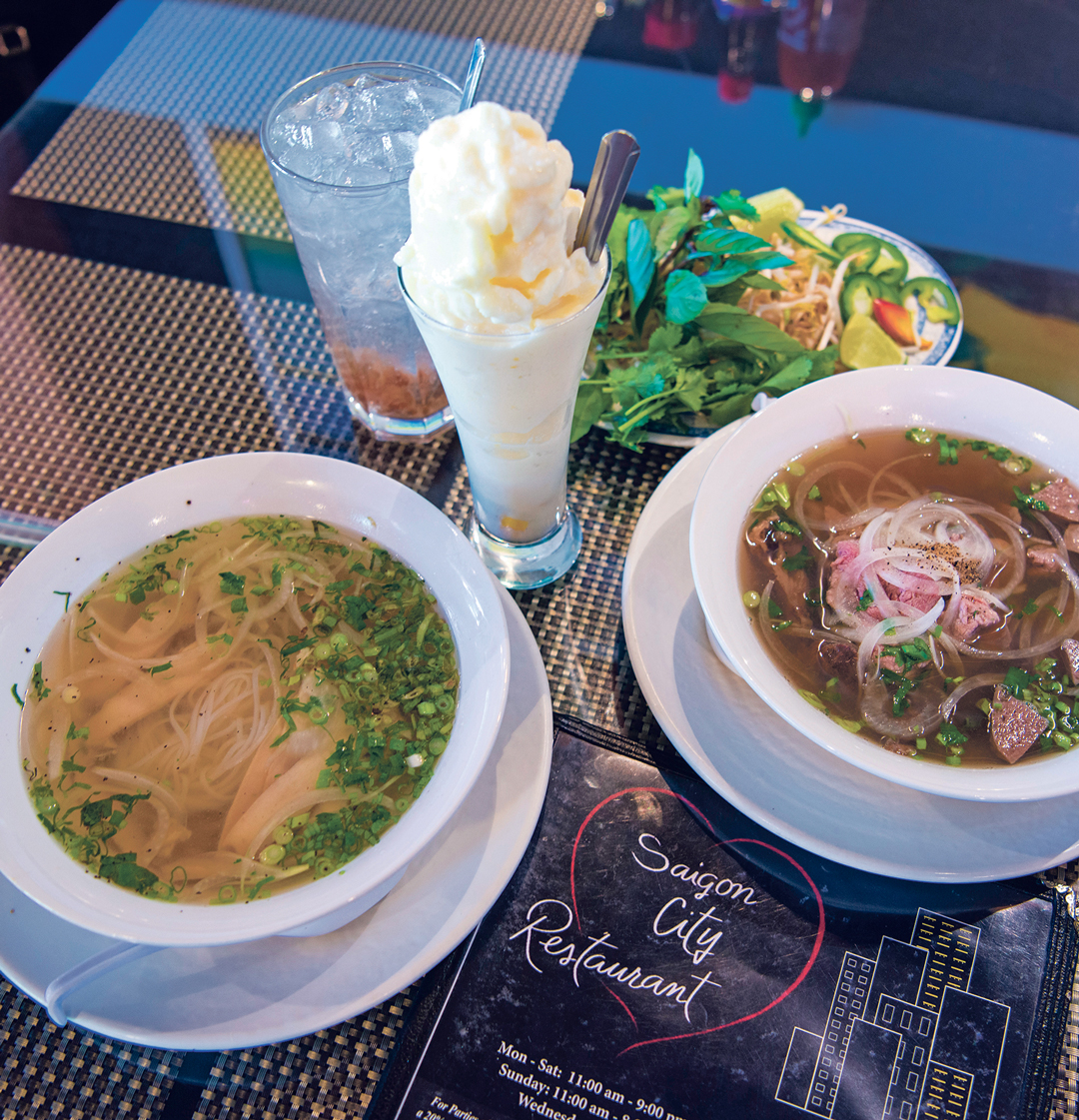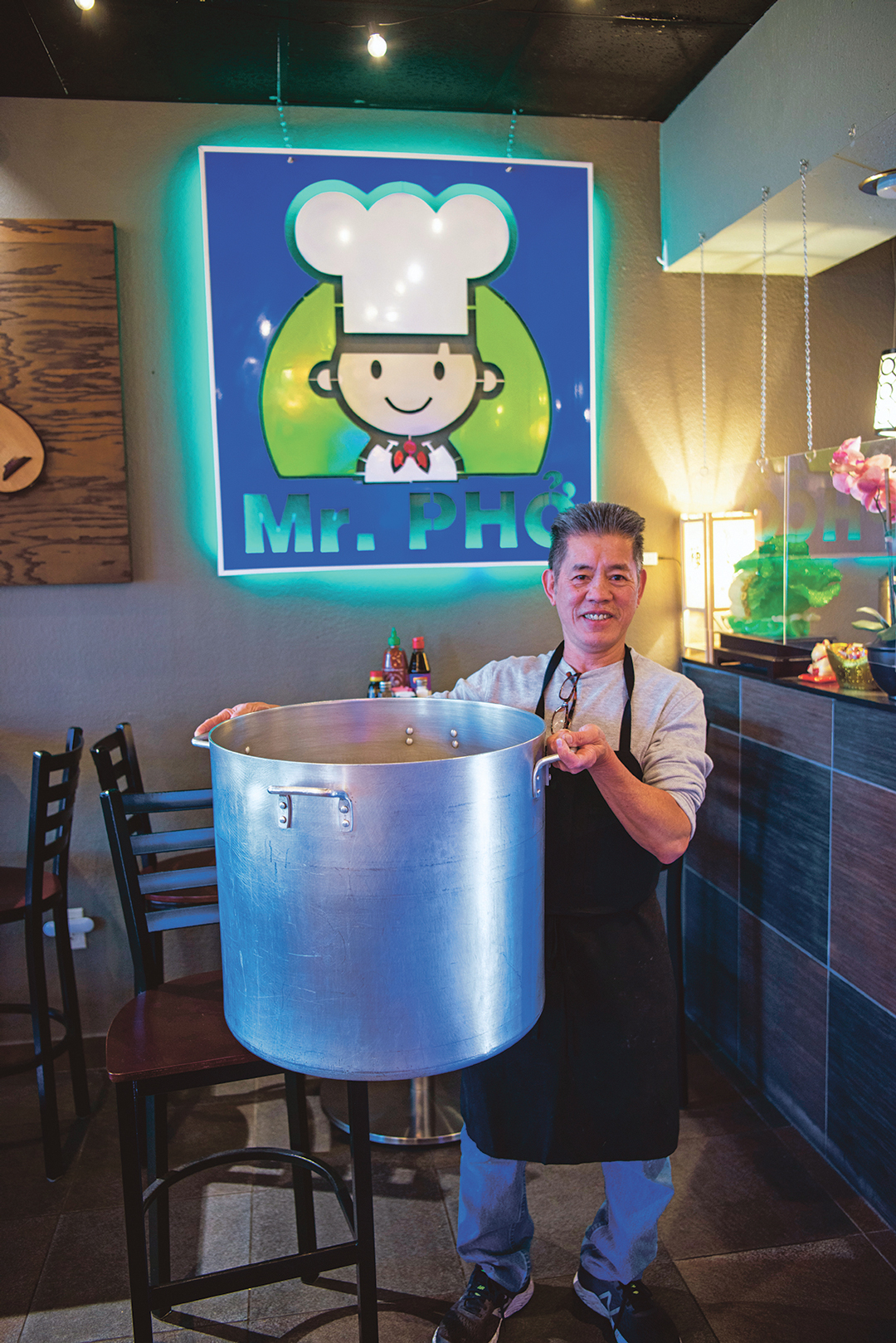
There are at least twenty different places in Albuquerque where you can sit down and be nourished by a steaming bowl of phở, and in every bowl you will find a different variation of this beloved Vietnamese rice noodle soup. Some phở warms the air and wraps the tongue in aromatic tones of clove and ginger, while other phở lightly teases the taste buds and then goes right to your core.
I once saw a cartoon of a girl swimming in a bowl of phở. As I slurped my way through Albuquerque, this image kept popping into my head. With every bowl of beef, chicken, meatball, combination, vegan, or vegetarian phở I devoured, I discovered something different and lovely. I found I craved the sweeter and more robust flavors of a Southern Vietnamese–style phở broth on Friday, and then fell in love with the lighter flavors of a clear Hanoi-style broth on Saturday. By Monday, I wanted something in between and with a whole lot of chile. I was playing the phở field and finding pleasure in every sip. But what, I asked myself, separates the phở that is fun from the phở you want to marry? What I found? Phở, really good phở, isn’t so much about the flavor. It’s about the feeling.
That feeling is a girl splashing around in bone broth, lounging on a soup spoon, twirling around a noodle, wearing a meatball for a hat. Let me explain: While all the phở I had tasted great, only a handful left me feeling euphoric, drunk even, imagining myself shrinking down like Alice in Wonderland to the size of broccoli and dunking myself into my soup. Only a few bowls left me feeling like a full, ripe blueberry—about to burst but also light enough to float out the door.
I determined that the “phở feels,” as I call them, are a result of the hard-core nutrients in the bone broth. You can almost feel every cell in your body plumping up and smiling and you think to yourself, “This is how I was designed to feel every day if I remembered to drink water, take my vitamins, and stop eating wine for dinner.” And this makes perfect sense, because pretty much any Vietnamese person will tell you that phở is all about the broth. It also explains why, of all the phở I ate, I couldn’t bring myself to finish the vegan version I tried that used a veggie bouillon rather than the light but satisfying chicken bone broth Cafe Da Lat uses for their tofu phở chay, which I ordered alongside their beef meatball phở bò viên, both of which left me feeling high and my one-year-old screaming and dancing, literally, for more.

Cafe Da Lat’s tofu phở.
In Vietnam, phở is a staple. My friend Lily Nguyen, who grew up in the south-coastal city of Nha Trang, tells me that she ate phở for breakfast, lunch, and dinner from the time she was a baby. James Nguyen, who has owned and operated Cafe Da Lat on Central since 2003, agrees.
“You can’t eat rice every day,” he told me. “It would be like having a hamburger three or four times a week. But you can eat phở every day.” And I did eat phở every day for a week, and I’m still not sick of it.

Phở gà and phở đặc biệt at Saigon City.
“One of my friends said eating phở is like someone hugs you from the inside. I totally feel that,” says Lily, who pointed me in the direction of Saigon City at the Shops @25, owned by restaurateur of twenty-five years Sean Tran. Here my journey into phởdom began, dragging along my aunty Naomi and my one-year-old daughter, Tachi’Bah, who I call the most honest food critic in the world.
Naomi ordered the phở gà, chicken pho, and I had the phở đặc biệt, beef combination, which included beef tripe, meatballs, brisket, tendon, and rare beef. It was here that my daughter discovered a passion for meatballs, which came in quarters rather than the usual round, spongy slices. But the real star of the meal was the rare beef, which melted in my mouth with a delectable tenderness I didn’t find anywhere else. The chicken in the phở gà was grilled, giving it an almost smoky flavor, and the broth had the same richness as the beef. I could have married them both.
At Saigon City, where they serve Southern Vietnamese–style phở, the bone broth is boiled for eight to ten hours, melding with about fourteen different herbs and spices, such as ginger, grilled onion, star anise, clove, and cinnamon, to give it a delicious sweetness. Saigon City set the bar high for me as I floated out of the restaurant and on to my next bowl of ambrosia.

Tung Tang of Mr. Phở.
Tung Tang opened Mr. Phở, located at Montgomery and San Pedro, seven years ago, after a forty-year career of professional cheffing. Wanting to sample something with Thai chile, I made a rookie mistake and ordered the #13 Special, which turned out to be a different type of soup called bún bò Huế, named for the central Vietnamese city of Huế that encompasses the Imperial City. Bún bò Huế has a distinct flavor profile, using lemongrass, pork broth, and a fat round rice noodle called bún, rather than the skinny, flat bánh phở noodles used in phở, including the meatball phở bò vien that my husband ordered.
Full of savory flavor of their own and with a nice texture, the homemade meatballs at Mr. Phở were the best I found, and my daughter seemed to second that opinion, stuffing them in her face with both hands.
To begin Mr. Tang’s phở bò broth, he boils forty pounds of beef and seventy pounds of bones for twenty-four hours to create 150 gallons of broth every three days. I could have sat inside the pot he lugged out from the kitchen to show me. He keeps his use of sweet spices like cinnamon and star anise to a minimum, creating a more savory dish that lets the taste buds focus on the fresh flavors of cilantro, chives, and red onions, and the juicy texture of those heavenly meatballs.
Splitting the difference between Mr. Phở’s savory broth and Saigon City’s sweet broth is Cafe Da Lat, which does a nice job of balancing a broth that has notes of nutmeg, cinnamon, and star anise but also the rich flavor of the bone broth itself, which is boiled for at least sixteen hours. If my daughter’s over-the-top reaction to the broth is any indication, Mr. Nguyen is getting it right. “I don’t like it to be too strong,” he tells me. “We keep the flavor but don’t let it explode.”

Ungelbah Dávila
Ungelbah Dávila lives in Valencia County with her daughter, animals, and flowers. She is a writer, photographer, and digital Indigenous storyteller.


